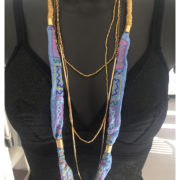Buy Handmade, Change Women’s Lives.
LAST PIECE !!
To those who are looking for something completely different, look no more 😉
This “mola” necklace -a technique used by women of the Kuna community in Colombia- will turn heads.Embroidered textile (read the IMPACT page on the meaning of the embroideries) and goldlayered chains are a statement in itself.
Length : 41″
| Weight | 10 kg |
|---|
This jewelry is inspired by the beauty of the Colombian landscapes with palmtrees and bananatrees, with settlements where women in colorful clothing adorn themselves with typical handmade jewelry, born of their unique ancestral traditions.
About 60 indigenous women work on the jewelry ; of the Kuna ethnicity, who work with molas (textiles made through ancestral applied embroidery techniques), and Embera Chami indigenous women who work with crystal beads embroidery. Each embroidery and artisanal piece made by these communities has an ancestral legacy, and a special meaning related to their cosmogony and traditional beliefs.
The origin of molas is born from the tradition of Kuna indigenous people of tattooing their bodies, which was later modified and transferred onto fabric designs. Molas represent their cosmogonist view of the origin of the universe. The Kuna indigenous people believe that people, plants and animals are interconnected through paths, which are represented in the fabrics’ complex labyrinths. Embera indigenous women make use of handmade looms, to work with their crystal bead embroideries. During colonial times in Colombia, these embroideries were usually made with gold beads and seeds.
These women receive an income for their work which is significant to them and their families, and in turn allows them to teach these techniques to younger generations, helping to guarantee the preservation of this cultural legacy over time.
About 60 indigenous women work on the jewelry ; of the Kuna ethnicity, who work with molas (textiles made through ancestral applied embroidery techniques), and Embera Chami indigenous women who work with crystal beads embroidery. Each embroidery and artisanal piece made by these communities has an ancestral legacy, and a special meaning related to their cosmogony and traditional beliefs.
The origin of molas is born from the tradition of Kuna indigenous people of tattooing their bodies, which was later modified and transferred onto fabric designs. Molas represent their cosmogonist view of the origin of the universe. The Kuna indigenous people believe that people, plants and animals are interconnected through paths, which are represented in the fabrics’ complex labyrinths. Embera indigenous women make use of handmade looms, to work with their crystal bead embroideries. During colonial times in Colombia, these embroideries were usually made with gold beads and seeds.
These women receive an income for their work which is significant to them and their families, and in turn allows them to teach these techniques to younger generations, helping to guarantee the preservation of this cultural legacy over time.













There are no reviews yet.